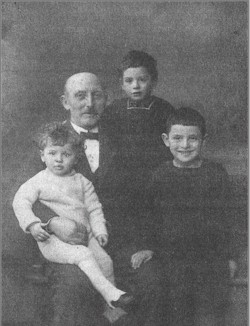
...My
grandfather
would set aside a portion of each day for my brother and me. I
treasured
those times together, listening to grandfather tell us a Bible story
and
relating it to a personal experience, or simply conversing with him...
1920.
Grandfather
Kalman Wolff
with
Cousin Carlo on left,
brother
Bruno in front and
Walter
in the rear.
|
This
book is dedicated
to the memory of
Steven
Reinheimer
President of
the Holocaust
Committee of Long Island
and
My Belowed Wife
Vittoria
Wolff, nee Fubini,
of blessed
memory
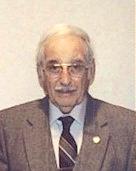
Walter Wolff |
| Walter
Wolff tells the neglected
story of how the Italian people courageously expressed their basic
humanity
and goodness despite the Nazi opposition. Walter's youthful innocence
died
during the rioting of Kristallnacht. After an unlikely release from
Dachau,
his family fled to Italy. There he survived time and again
because
of the willingness of strangers to risk their lives on his behalf. Now
living in New York, Walter is much sought after lecturer on the
Holocaust.
His survival in Italy taught him what is his closing refrain after
every
speech. " You should love thy neighbor as thyself." Through all
his
travels Mr. Wolff kept a remarkable collection of photographs and
official
documents which give his narrative a chilling sense of reality. |
| "Walter
Wolff has written
a narrative that embodies one man's belief in God, family, and the
godness
of the common person in the midst of history's worst nightmare.
His
story chronicles the refusal of the ordinary Italian citizen to
participate
in the Final Solution, which was in stark contrast to their
counterparts
in Germany and occupied Europe, This wonderful book explodes the Nazi
Myth
of universal acquiescence to the Final Solution. The Torah
states:
"He who saves one life, saves the world." Eighty-five percent of
Italian
Jewry survived the Holocaust because of people who had the courage to
care.
Mr. Wolff is a coraugeous, witty, and resourceful man. His
adventure
resemble a circus highwire act where one miscalculation could be
fatal.
The author weaves a tale of action and intrigue which leaves the reader
with a sense of exhilaration. Mr. Wolff is a man with an indominable
spirit
who personifies the quality of courage, optimism, resourcefulness, and
a love for all mankind. His narrative should be required for
young
and old alike." -Vincent E. Marmorale, New York State
Order
Sons of Italy in America |
| "Walter
Wolff eloquently
relates the story of his survival and triumph over the Nazis. He
has masterfully transformed the pain and suffering he has endured into
a message of hope, tolerance and faith for future generations to
cherish.
Mr. Wolff continues to live and breathe his past by integrating his
unique
life experiences into an ever blossoming tomorrow." -Dr.
Chaim
Wakslak, Rabbi, Young Israel of Long Bach |
The
Italian and Jewish
communities of St. Louis found a common link in Walter Wolff, a savvy
and
likeable retiree from Long Island (N.Y.) who came to promote his book
“Bad
Times Good People” and to recount his past as survivor from Dachau,
saved
by an entry visa to Italy and by the humanity of Italians encountered
during
the dark days of the war and the military occupation. By
arrangements
of the Consulate General of Italy in Chicago and the midwest office of
NIAF (National Italian American Foundation), the Italian community of
St.
Louis (Missouri) welcomed Walter Wolff, a former detainee in the
concentration
camp of Dachau, who, together with his mother and brother obtained an
entry
visa to Italy from an Italian Consul in Germany. Other countries,
including the United States, had refused such visa request. Walter
Wolff
who was born in Aachen in 1917 and who lived in Frankfurt until the
eruption
of anti-Semitism (Cristalnacht) is the author of a collection of
memories
by the meaningful name of “Bad Times Good People” from which half a
century
later his life as a war refugee in Italy comes to light, at first in
Genova
and later in various sites of internment and controlled residence
(Campagna,
Ferramonti, Casale Monferrato, Ponte Chiasso e Milano) all of which
were
stops of a precarious voyage toward survival, reached with great
courage
and creativity but mainly thanks to the humanity of many Italian men
and
women, common citizens, but also clergy and police officers who in
direst
moments risked their own lives by helping the Wolff family escape
arrest
and deportation to the Reich’s lagers. In St. Louis, on June 6,
2001,
at a meeting organized by “Italiano Per Piacere” www.ItalyStl.com, a
unique
forum in the United States for the cultors of the Italian language,
Walter
Wolff recounted his life of racial prosecution in Italy during the war
and under the enemy’s occupation, and of his fortunate employment with
AGIP of Milano under the fictitious name of Valter Monti up until he
met
his wife to be, Vittoria Fubini, at the end of April in 1945 and
subsequent
emigration to New York in 1947. The following evening, June 7,
2001,
the Italians in St. Louis accompanied Walter Wolff to a meeting with
the
local Jewish community for a conference, this time in English, at the
“Jewish
Holocaust Museum” of Missouri. During the two days in St. Louis
the
aging survivor gained the admiration of all of those who were able to
get
close to him and to appreciate his composed and coherent remembrance of
a painful past, overcome by a series of fortuitous and providential
circumstances.
His audience appreciated his exceptional humanity and his exhortation
to
fight any form of prejudice and racial discrimination as well as his
gratitude
for all Italian men and women who risked their own lives to help him ,
according to the biblical precept of do unto others… Walter Wolff is a
member of the Social Justice Committee of the “Order Sons of Italy” in
New York. CONSULATE GENERAL OF ITALY IN CHICAGO
Franco
Giannotti
|
|
|
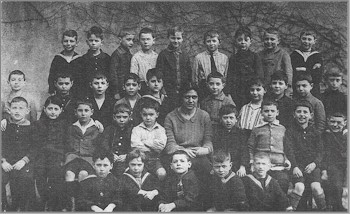
...The
school
I attended was officially a German public school, but operated under
the
auspices of the Frankfurt Jewish community. Parents were obligated to
pay
the school a “culture tax” for the privilege of sending their children
there...
1924.
Miss
Baer and class with
Walter
in front row center with tie
.
|
|
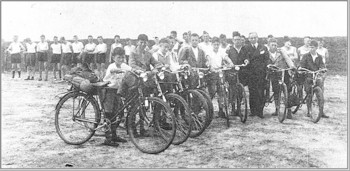
...I
also belonged
to the German-Jewish Youth Group, an organization affiliated with the
international
Boy Scouts movement...
1934.
Walter
is to the left
of
the
scoutmaster.
|
|
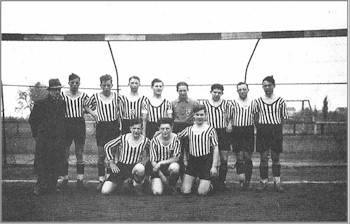
...Wednesday
was “Sports Day,” and our afternoon was devoted to playing soccer on
the
huge ball field behind our school...
1934.
Soccer
game. Walter is standing center, rear row.
|
|

...the
famous
Jewish sage, Hillel, who when asked by a non-Jew to explain the Torah
while
standing on one foot—in other words, to quickly and succinctly boil it
down to its essence—replied, “Love they neighbor as thyself is the most
important teaching in our Bible. All the rest is commentary”...
1934.
In
school
yard in Frankfurt.
Walter
is 17 years old
|
|
1934-1935.
Dr.
Plaut's class with Walter third from right, first row. The small class
size resulted from families fleeing Germany. It was in this class that
the gramophone was used to teach spoken English and French,
giving Walter the idea to learn Italian by attenting the cinema.
|
|
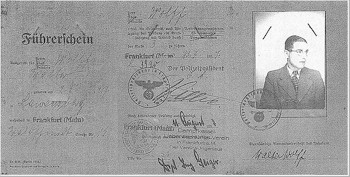
1937.
Walter's
first license to drive
|
|
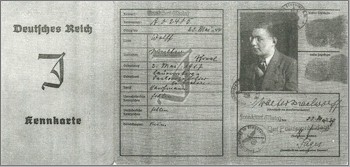
1939.
Walter's
official identification card, or Kennkarte in German. Notice that
after
Dachau his card was issued with the middle name "Israel".
|
|
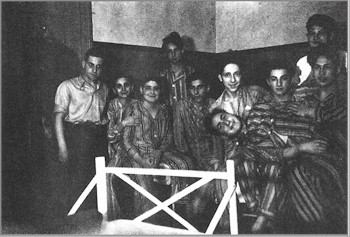
...the
Israelitic
community hired me to be the director of the Anlemwerkstätte, a
preparatory
school for youngsters preparing to make aliya (immigrate to Palestine).
I gave classes in Hebrew, and taught them about the Israeli kibbutz...
1939.
Walter (at far left) and his students
|
|
|
...In
Campagna,
the ratio of prisoners to guards was amazingly low: only two hundred to
five. This was in stark contrast to Hitler’s death camps in which
hundreds
of guards outnumbered and tormented the innocent victims continuously...
1940.
Group
picture of the internees at Campagna. Walter is seated in the fifth row
next to the man with the guitar.
|
|
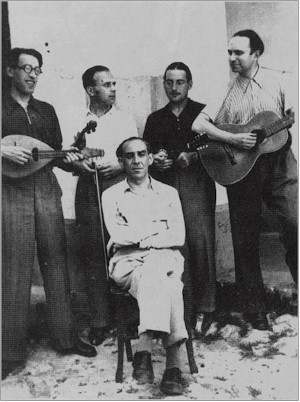
...A
choir
was also assembled along with a small orchestra. Since we had no
access to sheet music, we had to create our own, writing down the notes
from memory. We played Italian folk songs such as “0 Sole Mio” and
excerpts
from operas including Madam Butterfly and La Bohemè, among
others...
1940.
Walter's
little string group. Walter
is
second
from the right.
|
|
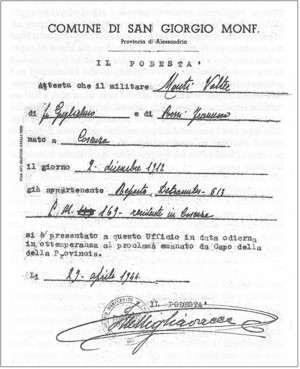
...I
asked
one of the employees for Giuseppe and he pointed me in the right
direction.
I approached him and barely speaking above a whisper, I told him that
the
local priest had sent me to see him. Knowing what that was all about,
he
nodded in agreement. Then, in a regular speaking voice, I provided him
with all of the necessary information. He stamped a few documents and
handed
me a sheet of paper with my name, “Signor Monti” on it. He also handed
me a booklet of ration cards. Nothing else was said. I thanked him and
casually walked away...
1944.
Walter's
false identification papers provided by Giuseppe (Municipality of San
Giorgio
Monferrato, Province of Alessandria)
|
|
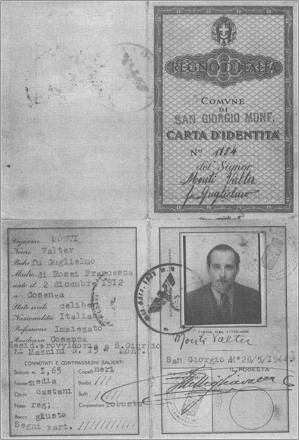
...I
returned
to the City Hall of San Giorgio Monferrato to see Giuseppe. I asked him
if he could possibly issue me an identification card with my picture
affixed
to it. He replied that this was possible only if I had a legal document
to prove my identiW I gave him the sheet of paper he had compiled a few
days ago. He glanced at the paper, looked at me, and winked his eye.
Nodding
in the affirmative and acknowledging that my document was legal, he
took
my picture and stamped it with the official seal...
1944.
Walter's
phony ID card, issued
in
the
name of Walter Monti.
|
|
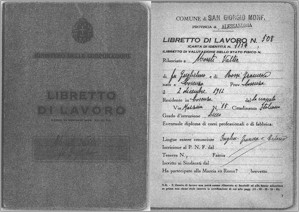 ...now
that I had an “official legal” document, Giuseppe could provide me with
the Libretto di Lavoro. Things were looking up. Even though Giuseppe
and
I encountered one another only twice in my lifetime, I owe him an
immense
debt of gratitude for risking his position as well as his life for
providing
me with the false identification papers... ...now
that I had an “official legal” document, Giuseppe could provide me with
the Libretto di Lavoro. Things were looking up. Even though Giuseppe
and
I encountered one another only twice in my lifetime, I owe him an
immense
debt of gratitude for risking his position as well as his life for
providing
me with the false identification papers...
1944.
Walter's
"working papers", without which one could not be hired.
|
|
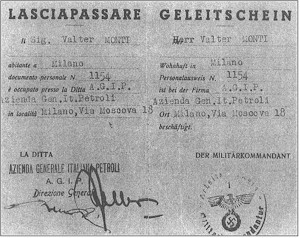
...since
my
only means of transportation was my bicycle, I had to apply for a
permit
in order to bike to my job in Milan. I had another document,
written
in Italian and German, declaring that neither the Italian nor the
German
Army could prevent me from doing my assigned work because I was
considered
“essential” for “the war effort.” In other words, if any officer or
soldier
of either the German or Italian Army were to interfere with my work, he
would face court martial... |
|
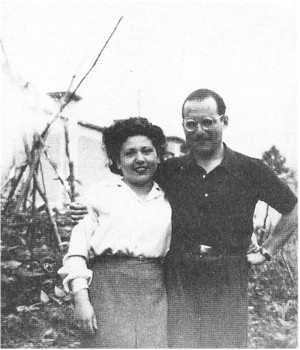
...then,
my
eyes made contact with an attractive young woman sitting alone at one
of
the tables. She had dark, wavy hair pulled back with combs and was
dressed
modestly in a taffeta dress. She looked vaguely familiar. I walked over
to her table. “Buongiorno, Signorina, but haven’t I seen you somewhere
before?” I asked her. “Did we meet in Rome or perhaps London—or was it
Paris?” Smiling politely, she replied, “I rather doubt it. You see, I
have
not lived such a glamorous life. My only home has been a small town
called
Casale Monferrato. Perhaps you have heard the name. It is not far from
Milan.”...
1945.
Walter
with his future bride Vittoria Furbini
|
|
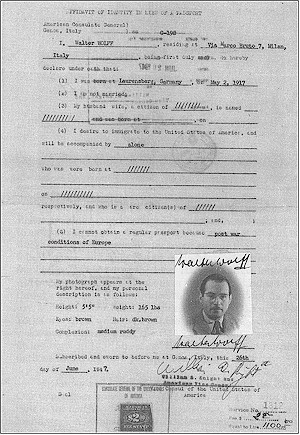 ...since
we had given up our passports ...since
we had given up our passports
before
entering
Italy, we had to apply for affidavits which would take the place of
a
passport.
Finally, in June 1947, we received our affidavits, which fortunately
had
low quota numbers, and we were free to immigrate to the United States.
We were ecstatic over the prospect of finally leaving Europe. But
we very much regretted leaving Italy. The Italians viewed the
Jews
as human beings rather than “enemies of the Reich,” and they treated us
well during the war. Italy was also a beautiful country blessed with
picturesque
vineyards, fresh sea breezes that drift in from the Mediterranean, and
breathtaking mountains. The Italian people provided the ingredients for
Italy’s inner beauty...
1947.
This
United States document was issued by the vice-consul as an affidavit in
lieu of a passport, so that Walter could immigrate to the United States.
|
|
|
|
|
Copyright
© 2001
- ItalyStl - All rights reserved
|
|







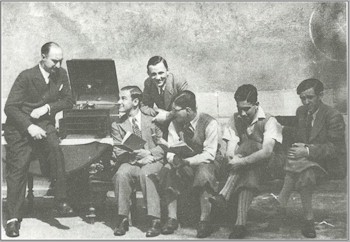







 ...now
that I had an “official legal” document, Giuseppe could provide me with
the Libretto di Lavoro. Things were looking up. Even though Giuseppe
and
I encountered one another only twice in my lifetime, I owe him an
immense
debt of gratitude for risking his position as well as his life for
providing
me with the false identification papers...
...now
that I had an “official legal” document, Giuseppe could provide me with
the Libretto di Lavoro. Things were looking up. Even though Giuseppe
and
I encountered one another only twice in my lifetime, I owe him an
immense
debt of gratitude for risking his position as well as his life for
providing
me with the false identification papers...


 ...since
we had given up our passports
...since
we had given up our passports